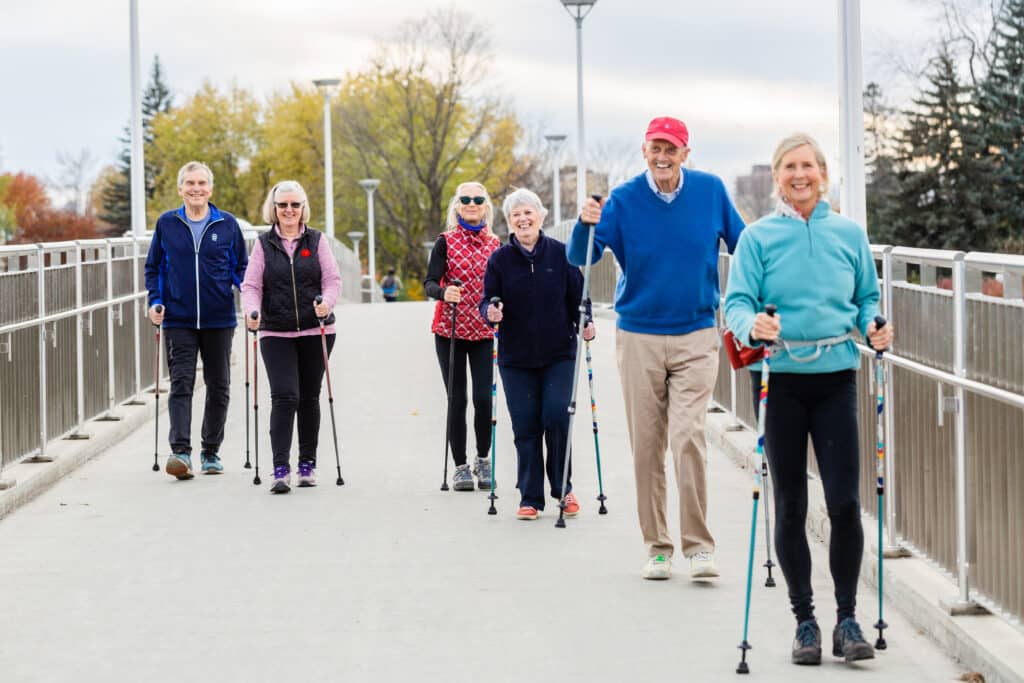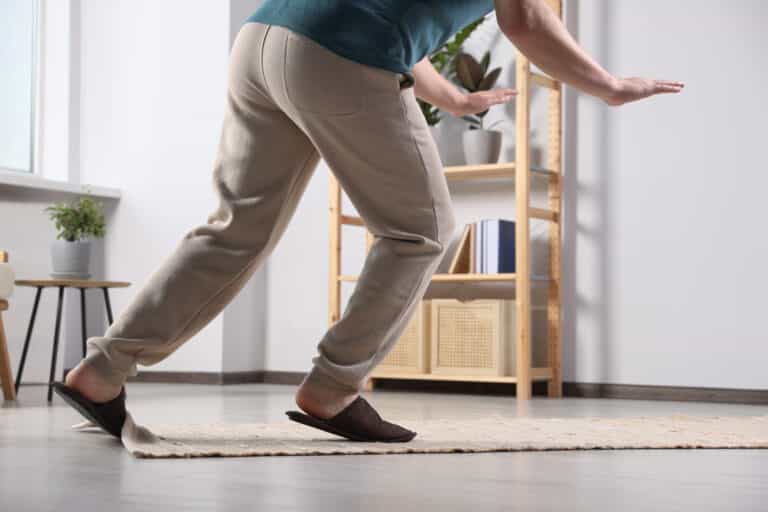Walking is undoubtedly one of the best forms of exercise for seniors. It can help you stay fit, prevent disease, and improve your mental well-being.
However, walking can pose some challenges for older adults, such as joint pain, fatigue, and increased fall risk. Many seniors are turning to walking poles to minimize these downsides and increase their physical activity so they can enjoy the benefits of walking. These easy-to-use devices can not even enhance your walking experience by utilizing other body parts like your arms and core to stay stable and strong.
As a physical therapist who’s helped many older adults increase their strength and mobility, I’ve seen almost every type of walking pole; not all walking poles for seniors are created equally. However, the right walking poles can elevate the walking experience by providing additional stability and support, making walking more engaging and fun.
This concise guide will cover everything you need to know about walking poles, how to use them, and other potential options that may suit your needs.
Types of Walking Poles

There are many different walking poles, depending on your preferences and goals. Here are some of the most common types of walking poles and their features:
OUR RECOMMENDATION
Urban Poling’s Activator™ Poles are the fitness poles we recommend to everyone in our clinic. Originally designed by an occupational therapist, they are the go-to recommendation by physical and orthopedic specialists.
Our recommendations are the same items we trust and prescribe to patients. When you buy through links like this on our site, we may earn an affiliate commission to support new content.
Solid Walking Poles
Solid walking poles are a versatile and popular variety that can be used for outdoor activities such as casual walks, hiking, and backpacking. Like a ski pole, solid walking poles can help you navigate various terrain more safely and securely in varying weather conditions.
The most significant benefit of solid walking poles is that they are very secure relative to other types of walking poles, primarily because they do not have an adjustment mechanism that could fail during use.
Adjustable Walking Poles
These poles have multiple locking mechanisms along the pole for height adjustment. Generally speaking, adjustable walking poles can be used in the same situations as solid walking poles.
The greatest benefit of adjustable walking poles for seniors is their versatility. You can adjust the length on the fly to help support your joints and balance during walking. This is especially helpful when walking uphill or downhill when the size of the pole can be slightly adjusted for a smoother experience.
Due to their unique balance of stability and adjustability, these are the best poles for most older adults I work with.
Z poles
Z poles are hybrid walking poles that fall between solid and adjustable poles. These poles usually include three distinct segments held together by a small internal cord that can be assembled and disassembled as one piece.
While this type of walking pole isn’t my favorite choice for seniors, it can still provide increased safety while helping offload joint stress during walking. Since the height of these poles can’t be easily adjusted, it’s important to get fitted for the correct size before purchasing.
Like adjustable poles, these are more accessible during travel, as some models can fold down to fit into a backpack.
Now that we’ve covered some basic types of walking poles, let’s discuss why they can be helpful for seniors during walking or hiking.
The Benefits of Walking Poles

Walking poles can benefit seniors who want to improve their exercise comfort and endurance. However, it depends on your exact needs.
Here are some of the highlights that I cover when discussing walking poles with my senior patients:
Pain Relief
Walking poles can reduce the stress and impact on your knees, hips, and ankles. For many older adults, this relieves pain from arthritis, muscle strains, and ligament sprains.
This makes walking poles especially helpful for older adults recovering from an injury. Injuries often prevent older people from getting out and walking comfortably to maintain their fitness. In my experience, this has been proven to be one of the most critical uses for walking poles for seniors.
Balance
The biggest benefit while using walking poles might simply be the confidence that comes with feeling secure when exercising outdoors.
Walking poles can help improve your balance and stability by providing four points of contact with the ground instead of two. This can help you avoid falls and increase your confidence while walking, especially if you struggle with a condition that increases your fall risk.1
Even with good balance, walking poles can help you cope with uneven or slippery surfaces like gravel, snow, or mud. They’re an added layer of security that you can count on in otherwise balance-challenging situations!
Energy Conservation
Finally, walking poles can help you conserve energy and reduce fatigue by evenly distributing the work between your upper and lower body muscles.2
Using your arms incorporates the upper body to delay fatigue in the lower body. This can help you walk more quickly without getting tired as easily. It also burns more calories by using more muscles — a nice bonus for those who want to get the most exercise potential from their walks.
Walking Poles vs. Canes: Understanding the Difference

Walking poles and canes offer similar support but are designed for different purposes.
Canes are primarily used for daily support. They help people with challenges walking because of medical conditions, surgeries, or injuries. A cane’s main job is to provide stability and reduce weight on a weaker or painful leg, making everyday tasks safer.
On the other hand, walking poles are usually used in pairs for activities like walking or hiking. They do more than help with balance. Walking poles involve the upper body, promoting better posture and evenly spreading the effort between arms and legs. This means that walking becomes an activity that engages the whole body.
In short, while both canes and walking poles offer support, they cater to different needs and activities. Knowing the difference can help seniors choose the right tool for their mobility goals.
Choosing A Walking Pole
Interested in trying walking poles? If so, you’re probably wondering how to choose the right ones for your needs and how to use them properly. While walking poles are relatively easy for most people to use, there are some crucial details to consider when choosing the right pair for you.
When choosing walking poles, you should choose walking poles that are comfortable, durable, and suitable for your height and activity level. The main factors are size, weight, material, grip, and adjustability.
Here are some general guidelines on how to choose a good pair of walking poles:
Size
The ideal length of your walking poles depends on your height and the walking you do.
A simple way to measure the correct length is to hold them with your elbows bent at 90 degrees and your forearms parallel to the ground. In this position, the tips of the poles should touch the ground, and your wrists should feel relaxed.
Weight
The weight of your walking poles affects how easy they are to carry and swing. Make sure to choose walking poles that are light enough not to tire you out quickly but not so light that they feel flimsy or unstable.
The weight of walking poles varies depending on the material, design, and features, so expect some variation between different brands and designs.
Material
The material of your walking poles affects their strength, durability, and price. The most common materials for walking poles are aluminum and carbon fiber.
Generally speaking, carbon fiber is more expensive, lighter, and more shock-absorbing than aluminum. However, carbon fiber is also more brittle and susceptible to cracking or snapping than aluminum.
In my experience, casual walking or hiking will not push either of these materials to their limits, so it is best to focus on your preference.
Grip
The grip of your walking poles affects how comfortable and secure they feel in your hands. You’ll want to choose a grip that fits your hand size and shape and the weather conditions you walk in. The most common grips are made of cork, rubber, foam, and plastic.
Cork is the most comfortable and breathable type of grip because it molds to your hand shape and absorbs sweat, but it’s also the most expensive option.
On the other end of the spectrum, rubber is the most durable and shock-absorbing type of grip because it withstands wear and tear and reduces vibration. However, rubber is also the heaviest and least breathable type of grip, which can cause blisters or chafing in hot or humid weather.
Note: For most patients, foam tends to be their favorite grip material. It’s the lightest and softest type of grip, providing cushioning and insulation for your hands. While it is less durable than other options, it balances quality and price well.
Adjustability
The adjustability of your walking poles affects how easy they are to use and store. I always recommend choosing walking poles that are adjustable in length so you can adapt them to different terrains and preferences.
For example, you may want to shorten your poles when going uphill or lengthen them when going downhill, which can greatly affect the overall difficulty of your walk.
Common Adjustment Devices You May Encounter
Twist, lever, and push-button locks are the most common mechanisms for adjusting walking poles.
Twist locks are the oldest and most straightforward mechanism, requiring you to twist the pole sections to lock or unlock them. However, twist locks are the least reliable and secure, as they can loosen or jam over time or with exposure to dirt or moisture.
Lever locks are the most popular and user-friendly mechanism. You simply flip a lever to lock or unlock the pole sections. Lever locks are also the most reliable and secure mechanism, providing a firm hold and a quick adjustment. For these reasons, I always recommend this locking mechanism to my patients.
Push-button locks are similar to lever locks but require pressing a button instead of flipping a lever to lock or unlock the pole sections. Push-button locks are also reliable and secure, but they may be harder to operate with gloves or cold fingers. Folding systems are the newest and most innovative mechanism, as they allow you to fold or unfold the pole sections like a tent pole with a single pull or push. Folding systems are the most compact and convenient mechanism, significantly reducing the poles’ size when folded.
Best Practices for Using Walking Poles

Once you’ve chosen the best walking poles for your needs, you must learn how to use them properly to get the most out of them. Here are a few tips to help you get started on the right foot:
Holding the poles
The first step to using walking poles is to hold them correctly. You want to hold the poles with a relaxed but firm grip without squeezing or clenching your hands. We do not recommend using the straps for everyday exercise and walking. There is a risk of injury if there is a stumble and your hand is tethered to the walking stick.
Adjusting the poles
The next step to using walking poles is to adjust them to the correct length for your height and the terrain. Generally, you want to adjust the poles so that your elbows are bent at 90 degrees, and your forearms are parallel to the ground when holding the poles. However, you may want to adjust the poles to be slightly shorter or longer depending on the slope and your preference.
For example, you may want to shorten the poles by 5 to 10 centimeters when going uphill and lengthen them by 5 to 10 centimeters when going downhill. This way, you can maintain a relaxed posture and a natural stride while walking.
Walking with the poles
The final step to using walking poles is to walk with them in a smooth and coordinated manner. Walking with the poles in a reciprocal pattern is best: moving the opposite pole and leg together.
For example, when you step forward with your right leg, you swing your left pole forward, and vice versa. You should also plant the poles slightly behind your feet, not in front of them, as this can help you propel yourself forward and avoid tripping over the poles.
Walking with poles can take some practice, but don’t give up! Once you have established the rhythm of moving the poles with your body, you can reap the benefits of using walking poles quickly.
Walking Poles for Seniors: A Physical Therapist’s Opinion
After exploring the vast benefits walking poles offer, it’s clear they are more than just a walking aid—they’re a gateway to enhanced mobility and independence for seniors. Walking poles not only provide the physical support needed to tackle joint pain, balance, or fatigue, they also imbue users with the confidence to remain active, explore more, and enjoy the myriad health benefits of walking with added security.
The true beauty of walking poles lies in their ability to adapt to your needs, acting as a companion that enhances your walking workout. Whether you’re navigating the neighborhood or exploring nature, walking poles serve as a testament to your commitment to staying healthy, balanced, and active.
It’s important to recognize that walking poles are not a sign of dependency, but rather a tool for empowerment. They are a means to extend your ability to engage in physical activity safely and with confidence. As you grow more comfortable and your strength and endurance improve, you may find yourself relying on them less. However, there’s no harm in making them a permanent part of your exercise routine if they continue to provide that extra layer of stability and support.
We encourage seniors to view walking poles as an ally in their journey toward maintaining an active lifestyle. By selecting the right poles and using them effectively, you can unlock a new level of exercise potential. Remember, the goal is always to enhance your quality of life and independence, and walking poles are here to help you achieve just that.
So, take your walking poles with you on your next adventure confidently. They are not merely a tool for assistance but a symbol of your commitment to leading a vibrant, active, and healthy life.
Key Takeaways
- Walking poles are long, lightweight sticks you hold in your hands and use to propel yourself forward while walking. They can provide extra stability, support, and comfort when you walk. This makes it easier and more enjoyable for you to explore different terrains and distances.
- Different walking poles exist, such as solid, adjustable, and Z poles. Each design has various features, advantages, and disadvantages depending on your needs. You should always choose the type of walking poles that suits your preferences and goals.
- Walking poles can benefit seniors who want to improve their health and mobility. Some of their key benefits are providing support to reduce pain, improve balance, and increase endurance.
- To use walking poles effectively, you must choose the right ones for your needs and use them properly. For safety, learn how to hold, adjust, and walk with your poles in a smooth and coordinated manner.
- Although walking poles can offer many benefits, they should only be used when needed. Maintaining your independence long-term is always the primary goal. Walking poles should be used to increase your activity level whenever you need help reaching that goal.
References
- Ono K, Nishimoto J, Imura T, Mitsutake T, Inoue Y, Tanaka S, Tanaka R. The effects of walking training with poles on walking ability: A systematic review and meta-analysis of randomized controlled trials. PM R. 2023 Aug;15(8):1026-1037. doi: 10.1002/pmrj.12886. Epub 2022 Oct 13. PMID: 35943832.
- Gomeñuka NA, Oliveira HB, da Silva ES, Passos-Monteiro E, da Rosa RG, Carvalho AR, Costa RR, Rodríguez Paz MC, Pellegrini B, Peyré-Tartaruga LA. Nordic walking training in elderly, a randomized clinical trial. Part II: Biomechanical and metabolic adaptations. Sports Med Open. 2020 Jan 13;6(1):3. doi: 10.1186/s40798-019-0228-6. PMID: 31932999; PMCID: PMC6957599.







